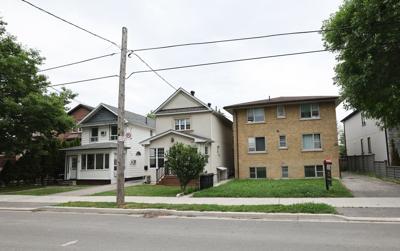When Karen Chapple, the director of University of ╔ź╔ź└▓’s School of Cities, heard that ╔ź╔ź└▓ city council had walked back a proposal to legalize sixplexes across ╔ź╔ź└▓ ÔÇö╠řelecting instead to legalize it only in nine wards╠řÔÇö╠řshe saw another barrier to a city push on density╠řthat has, so far, seen paltry uptake.
The push was part of a years-long effort that’s seen the city green-light other housing forms from╠řmultiplexes to backyard suites in areas╠řhistorically restricted to detached and semi-detached homes.
But despite being able to build multiplexes of up to four units across the city, that initiative only led to about 450 approved permits and 750 net new housing units in the 13 months after they were legalized. Chapple argues that limited uptake is╠řone reason to open the door even wider.
“People are not actually building ‘plexes right and left,” she said, noting the steep costs of developing a multiplex as one barrier. “So the city is going to have to make it as easy as possible to build to get any activity at all.”╠ř
Instead, the sixplex proposal ran into old divides in╠řa city╠řfundamentally split on many issues between its urban and suburban areas.╠ř
Aside from a single Scarborough ward where sixplexes were already being piloted, Scarborough, Etobicoke and North York were ultimately removed from the legalization plan in order to pass the changes in old ╔ź╔ź└▓ and East York╠řÔÇö with an option for those areas to opt-in to legalization at a later date.
Councillors for hours╠řon Wednesday debated how to best make that patchwork approach work. A motion from Coun. Gord Perks (Ward 4, ParkdaleÔÇöHigh Park) requested that city staff ensure the nine wards agreeing to legalize sixplexes had the services like street sweeping that they needed while accepting more density.
ItÔÇÖs a directive Coun. Brad Bradford (Ward 19, Beaches ÔÇö East York) tried to convince councillors to remove, suggesting it was going down a bad path to suggest that adding sixplexes would require more upkeep like street sweeping, and draw further divides between wards with differing service levels.
But Coun. Shelley Carroll (Ward 17, Don Valley North) questioned if some wards were willing to make “this massive leap on behalf of the rest of us,” should they not receive some level of additional support?╠ř
“I think it perpetuates this divide of different levels of services in different parts of the city, and I donÔÇÖt think thatÔÇÖs helpful,” Bradford said.
Council╠řwas split, with BradfordÔÇÖs motion failing to pass with 11 councillors in support and 12 opposed.
The watered-down legalization, which allowed sixplexes as-of-right in nine wards with the directive to ensure services like street sweeping were in place there, passed with 18 councillors in favour and opposition remaining from six╠řÔÇö the councillors for Etobicoke North, Etobicoke Centre, Scarborough Southwest, York Centre, Humber River ÔÇö Black Creek and Scarborough Centre.
Hanging overhead was the threat of lost funding, with the citywide sixplex proposal one condition of a $471-million housing deal between city hall and the federal government. A March 2025 letter to Chow from former housing minister Nathaniel Erskine-Smith warned that if ╔ź╔ź└▓ did not “fully implement” its agreed-upon initiatives on time, it could lose 25 per cent of its annual payout ÔÇö╠řa cut city hall says amounts to about╠ř$30 million.╠ř
As of Thursday, the fate of that money remained unclear, with a spokesperson for now-Housing Minister Gregor Robertson saying╠řthat it was ÔÇťworking closelyÔÇŁ with ╔ź╔ź└▓ city hall to meet its goals, adding its intention was to reward “ambitious housing initiatives” that removed zoning restrictions and red tape.
On Thursday, Coun. Bradford╠řsaid╠řthe compromise struck was “not what you want to see.” Discussions about density can be challenging, he said, and required groundwork to find consensus especially in a post-amalgamation city.
“The idea that a neighbourhood is static ÔÇŽ almost encapsuled in amber, or stuck in time, I donÔÇÖt think thatÔÇÖs practical or realistic,” he said, arguing cities needed to evolve. “Nothing is static and everything changes.”╠ř
Still, he is sympathetic to the idea that housing rules can vary depending on location. “ThatÔÇÖs been the premise of zoning bylaws since they were created.”
Coun. Parthi Kandavel (Ward 20, Scarborough Southwest), who opposed sixplex permissions in his area, said Thursday while amalgamation was decades past, the difference between ╔ź╔ź└▓’s old boroughs were still palpable.
“Whether its two years or 27 years, the built form hasnÔÇÖt changed tremendously,” he said. He pointed to density influxes in Scarborough such as the Golden Mile intensification, but argued that further change in lowrise neighbourhoods should come more slowly. “ItÔÇÖs evolving. We need time,” he said, arguing the impacts of fourplex legalization were still shaking out.
He isnÔÇÖt worried about the city having its federal funding yanked because of the walk-back. “Do I think weÔÇÖre going to lose the money? Heck no,” he said.
For some ╔ź╔ź└▓nians, though, the verdict on Wednesday was disappointing.
Zakerie Farah, a board member with housing advocacy group More Neighbours, said he was disappointed Mayor Olivia Chow didnÔÇÖt take a stronger stance to legalize sixplexes citywide, including by using her strong mayor powers.
Having grown up in Etobicoke, Farah said areas historically been dominated by single-family homes need to offer a mix of housing types to be accessible for young families, whose children could populate their local schools.
“ItÔÇÖs a housing crisis everywhere in the city╠řÔÇö not just a housing crisis downtown.”



























To join the conversation set a first and last name in your user profile.
Sign in or register for free to join the Conversation